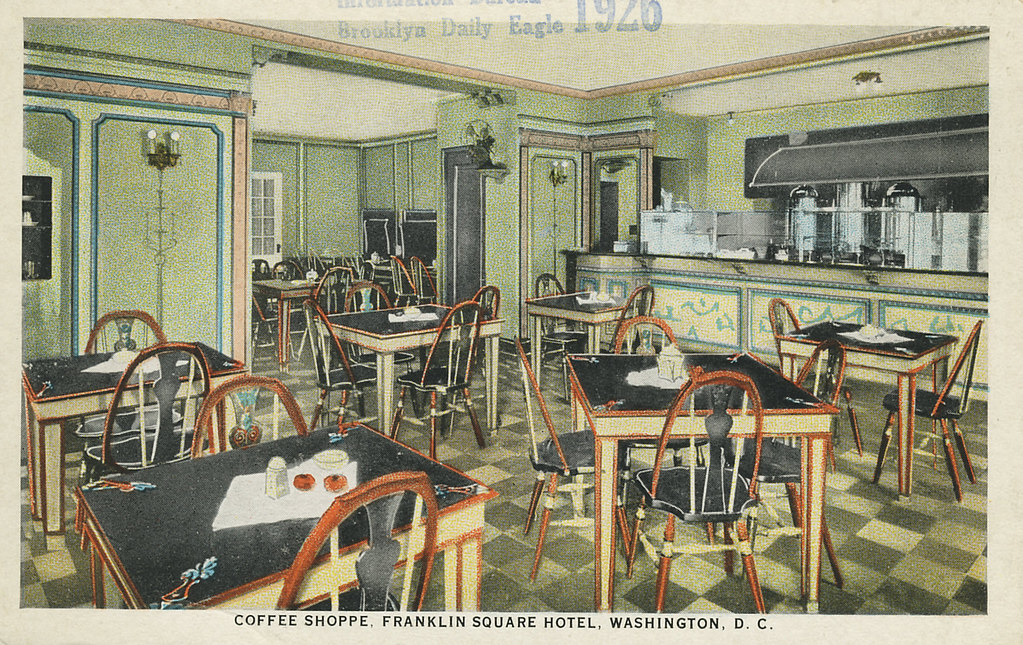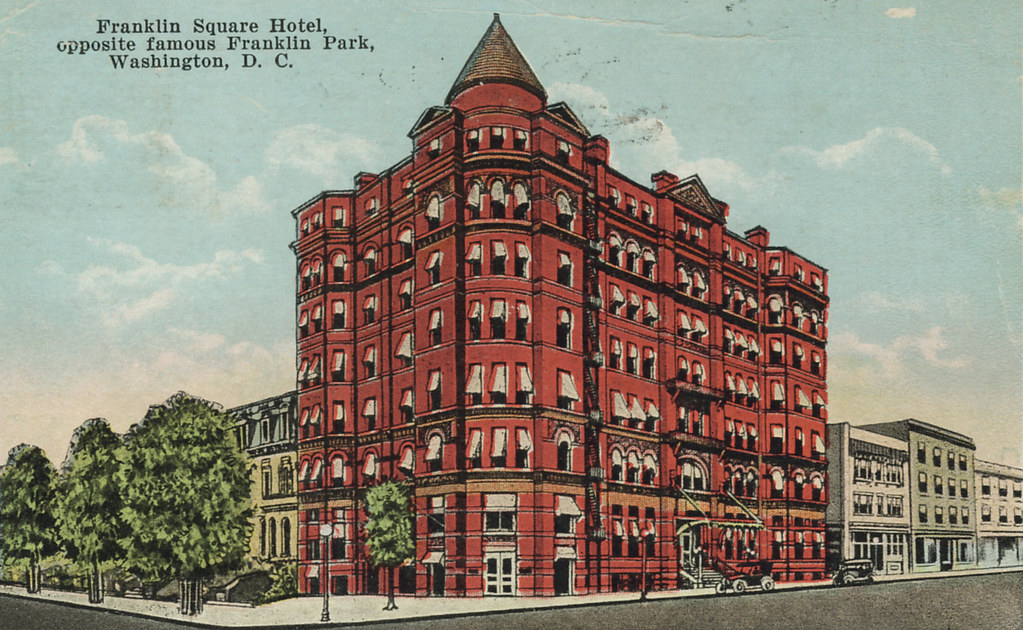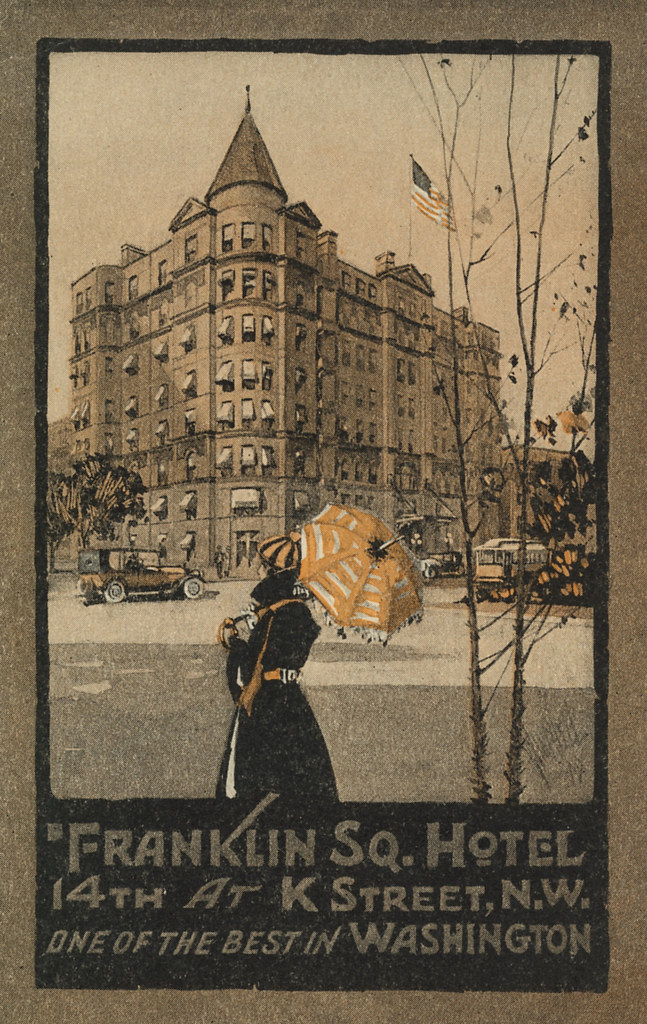The Franklin Square Hotel
The Franklin Square Hotel was a notable landmark on the northwest corner of 14th and K Streets, N.W. for many years. Designed by John B. Brady and completed in 1891, it took the place of a mansion that had been home to Hugh McCulloch, Secretary of the Treasury under Lincoln and Johnson. Originally opened as the Cochran Hotel, it cost $160,000 to build. The Washington Post, a reliable booster for all major real estate developments in those days, offered this review at the time of its opening:
Towering heavenward seven stories at the northwest corner of Fourteenth and K Streets is a model modern structure constructed of Hummelstown brownstone and pressed brick, inscribed Cochran, and designed for the purposes of a first-class hotel.... Acting under the instructions of the owner, no expense was spared to make the Cochran the model hotel structure of the Capital of the nation, and while equaled by few it is surpassed by none in this country, so well has the contractor fulfilled his instructions since assuming control....
Stairways connecting the various floors are iron-framed throughout and in the front portion of the house the steps are of white marble, while in the rear portion they are of solid iron, all being graduated so as to furnish an easy ascent. The lobby, where the office is situated, and, in fact, the entire first floor, is tiled with white marble, and a short flight of white stairs leads from the office to the entresol parlor, overlooking Franklin Park, Thomas Circle, and K Street.
From K Street, there is an entrance for ladies, and just upon the right of the main door at this point is a cozy reception room.... Imposing oaken doors are conspicuous in the square entrance on Fourteenth Street into the office, semicircular windows of French plate glass surmounting the doors... Hard wood and tiled mantels are prominent features in the 154 living-rooms, arranged en suite, every other room being provided with a private bath, and sanitary plumbing has been made predominant...
[A]ll the apartments of the Cochran have been elaborately and sumptuously furnished, the carpets being principally moquette, Axminster, and Wilton, while cherry, mahogany, and antique oak predominate in the woods used for the furniture.... Light draperies, exquisite in texture and design, are gracefully disposed of at the windows and doorways of the various suites....
Every precaution has been taken against fire and other accidents...in the corridor of each floor is a large fire gong and appliances for extinguishing flames at a moment's notice. Chemicals in small bottles are within easy reach, and long lines of hose are carefully coiled in readiness for instant use.... Cream-tinted tiles, similar to those used in the bathrooms and private apartments of the President's house, abound in the bathrooms of the Cochran, and the side walls are finished in gray Acme cement, similar in appearance to soapstone.
Distinguished people in every walk of public life are residents of the neighborhood in which the Cochran is situated, and the western boundary of the square upon which it is located is Vermont avenue, lined upon both sides with palaces of the wealthy and aristocratic of the United States...
With these glowing words, the hotel was off to a propitious start. It operated as the Cochran Hotel for the next 20 years or so before changing its name to the Franklin Square Hotel. By the 1920s, it was apparently struggling (unsuccessfully) to stay up to date. A brief newspaper notice in 1921 noted that architect P. M. Julien was suing the hotel, claiming he hadn't been fully paid for his services in remodeling it. The Franklin Square Hotel Company was further sued in 1926 by its landlord for $62,500 in back rent. The hotel soon folded, and the building was razed in 1928.
In its place, the new art deco Tower office building was constructed at a cost of $1.2 million. Designed by Robert F. Beresford, it was the tallest office building in the city when it was completed. Unlike the old pressed brick and brownstone of the hotel building, this new structure was a modern, limestone-clad steel structure, as cutting-edge in the 1920s as the hotel had been in 1891. The Tower building was renovated and restored in the 1990s.
Towering heavenward seven stories at the northwest corner of Fourteenth and K Streets is a model modern structure constructed of Hummelstown brownstone and pressed brick, inscribed Cochran, and designed for the purposes of a first-class hotel.... Acting under the instructions of the owner, no expense was spared to make the Cochran the model hotel structure of the Capital of the nation, and while equaled by few it is surpassed by none in this country, so well has the contractor fulfilled his instructions since assuming control....
Stairways connecting the various floors are iron-framed throughout and in the front portion of the house the steps are of white marble, while in the rear portion they are of solid iron, all being graduated so as to furnish an easy ascent. The lobby, where the office is situated, and, in fact, the entire first floor, is tiled with white marble, and a short flight of white stairs leads from the office to the entresol parlor, overlooking Franklin Park, Thomas Circle, and K Street.
From K Street, there is an entrance for ladies, and just upon the right of the main door at this point is a cozy reception room.... Imposing oaken doors are conspicuous in the square entrance on Fourteenth Street into the office, semicircular windows of French plate glass surmounting the doors... Hard wood and tiled mantels are prominent features in the 154 living-rooms, arranged en suite, every other room being provided with a private bath, and sanitary plumbing has been made predominant...
[A]ll the apartments of the Cochran have been elaborately and sumptuously furnished, the carpets being principally moquette, Axminster, and Wilton, while cherry, mahogany, and antique oak predominate in the woods used for the furniture.... Light draperies, exquisite in texture and design, are gracefully disposed of at the windows and doorways of the various suites....
Every precaution has been taken against fire and other accidents...in the corridor of each floor is a large fire gong and appliances for extinguishing flames at a moment's notice. Chemicals in small bottles are within easy reach, and long lines of hose are carefully coiled in readiness for instant use.... Cream-tinted tiles, similar to those used in the bathrooms and private apartments of the President's house, abound in the bathrooms of the Cochran, and the side walls are finished in gray Acme cement, similar in appearance to soapstone.
Distinguished people in every walk of public life are residents of the neighborhood in which the Cochran is situated, and the western boundary of the square upon which it is located is Vermont avenue, lined upon both sides with palaces of the wealthy and aristocratic of the United States...
With these glowing words, the hotel was off to a propitious start. It operated as the Cochran Hotel for the next 20 years or so before changing its name to the Franklin Square Hotel. By the 1920s, it was apparently struggling (unsuccessfully) to stay up to date. A brief newspaper notice in 1921 noted that architect P. M. Julien was suing the hotel, claiming he hadn't been fully paid for his services in remodeling it. The Franklin Square Hotel Company was further sued in 1926 by its landlord for $62,500 in back rent. The hotel soon folded, and the building was razed in 1928.
 |
| The hotel's coffee shop, from the 1920s. |
 |
| On April 3, 1928, a second-story wall collapsed while demolition work was underway. Two workmen were killed and five more injured. (Author's collection). |
 |
| The Tower Building (photo by the author). |






Is this the building that now houses DC Coast Restaurant?
ReplyDeleteYes, DC Coast is in the Tower Building now. The building was constructed at great expense and with high expectations, just before the stock market crash in 1929. The lobby had been designed to accommodate a prestigious bank that went under before it could move in. The space was then reconfigured for use as a restaurant.
ReplyDeleteFrancis "Frank" Littleton Hanvey was the contractor who built the hotel! He was my Great-Grandfather.
ReplyDeleteLizzie Borden's favorite hotel.
ReplyDelete